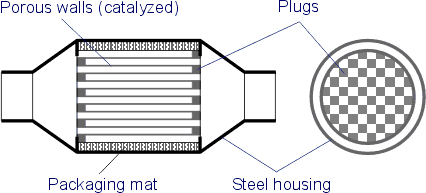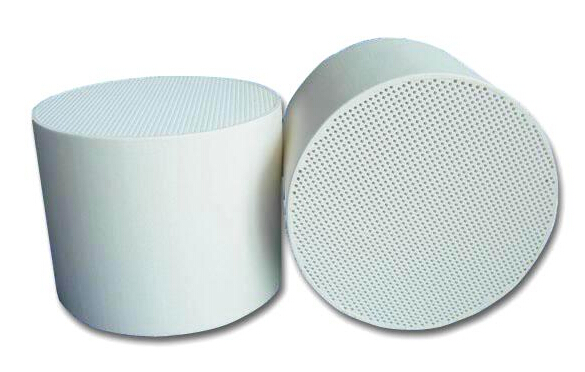Catalysed Diesel Particulate Filters
Traditional Diesel Particulate Filter systems consist of a filter material positioned in the exhaust designed to collect solid and liquid particulate matter emissions while allowing the exhaust gases to pass through the ceramic walls. Catalyzed Diesel Particulate Filters (CDPF) are designed not only to achieve collection efficiencies of 90% or greater in terms of mass (over 95% when expressed as number of ultra-fine particles), but also to burn off the collected particulate matter into carbon dioxide and water.
The incorporation of catalytic coating in CDPFs lowers the temperature at which particulate matter burns. To achieve this auto-ignite and the sustain combustion of collected particulate matter CDPFs must attain a minimum temperature of approximately 250C that can be helped by electrical heating if the engine-out exhaust temperature of a heavy-duty engine does not typically achieve this required temperature level.
Ceramic Diesel Particulate Filters
These types of particulate filters must be regenerated. Regeneration of a DPF is to remove accumulated soot/carbon. Two general approaches are continuous and intermittent regeneration. In continuous regeneration, a catalyst is provided upstream of the DPF to convert NO to NO2. NO2 can oxidize carbon at typical diesel exhaust temperatures and thereby effectuate continuous regeneration. A disadvantage of this approach is that it requires a large amount of expensive catalyst. This technique is not commonly used on cars but is found on public transport vehicles / council vehicles.
Intermittent regeneration involves heating the DPF to a temperature at which carbon combustion is self-sustaining in a lean environment. Typically this is a temperature from about 400 to about 700 degrees C., depending in part on what type of catalyst coating has been applied to the DPF to lower the soot ignition temperature. A typical way to achieve carbon combustion temperatures is to inject fuel into the exhaust upstream from the DPF, whereby the fuel combusts generating heat in the DPF or an upstream device. In most modern cars the catalyst is injected into the fuel tank and is effectuated through the fuel injection system.
Coated Diesel Particulate Filter
Ford’s optional cDPF system traps carbon deposits as they exit from the combustion system, preventing their release into the atmosphere. Under favourable conditions the system then cleans itself with a controlled ‘burn-off’ process, thus providing a self-contained clean air system without the need for service maintenance. This system contains a ceramic filter body of around 4 litres volume mounted behind the exhaust manifold plus a special regeneration support unit on the engine’s intake manifold. Together these components enable the filter system to regenerate in any possible drive condition automatically without requesting any input from the driver and without compromising drive ability noticeably during regeneration.
The advantages of the system are:
* Additive systems have an additional additive tank that primes the fuel tank with the additive (a metallic catalyst) at every refuelling. On the Ford cDPF the additive is embedded in the filter washcoat, hence no additional complex priming system is required and no refilling of the tank.
* Long life – a ‘normal’ additive DPF tank needs refilling after approx 60k km, whereas the new Ford cDPF has been developed to last at least 200.000km.”
Article Ref: Honest John
Tags: dpf cleaning, dpf delete, dpf filter, dpf problem, dpf regeneration, dpf removal, dpf services, dpf solution, dpf tuning





